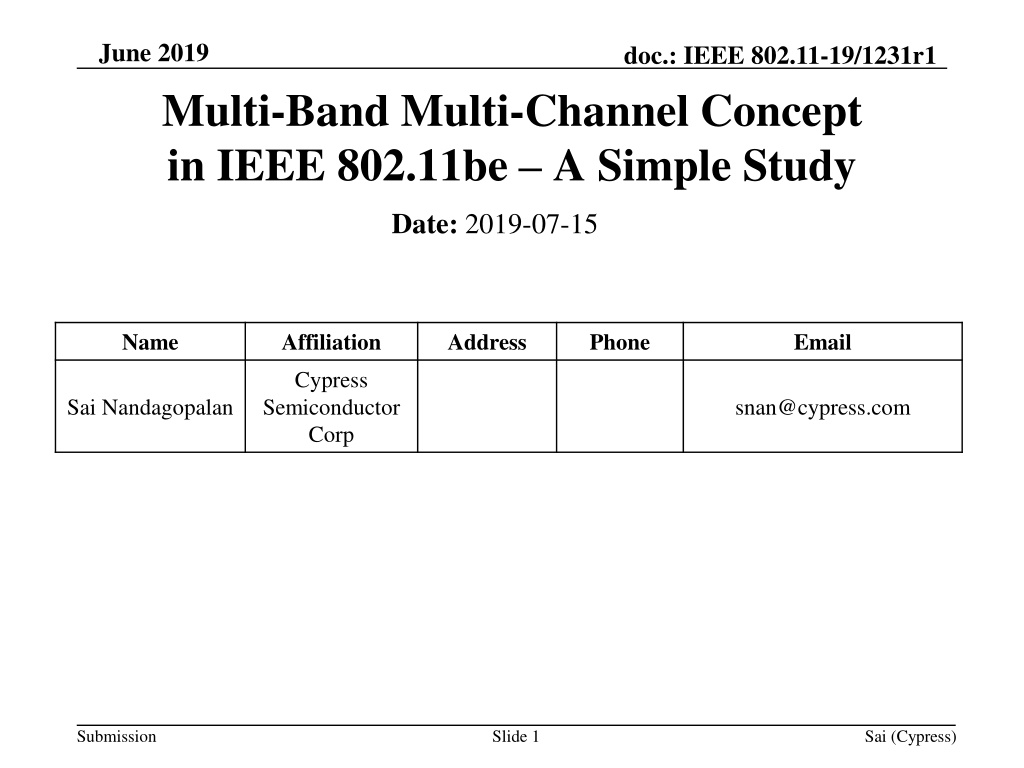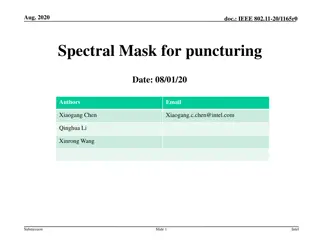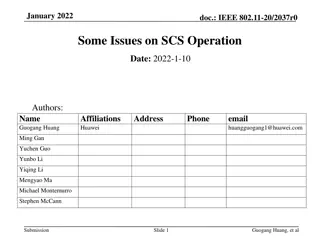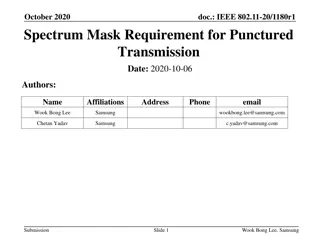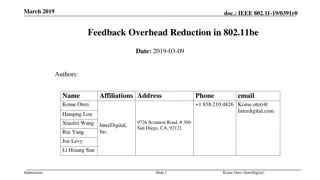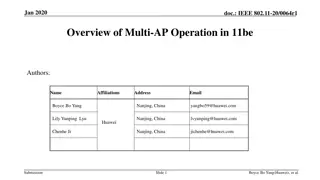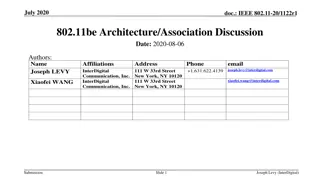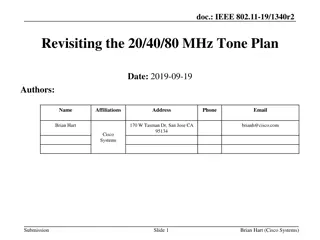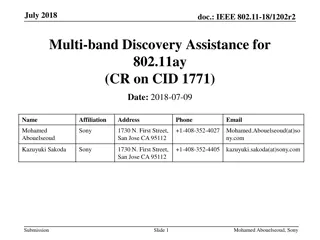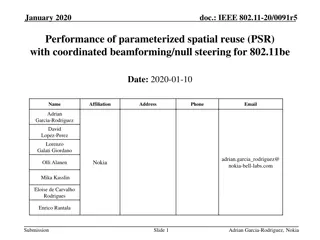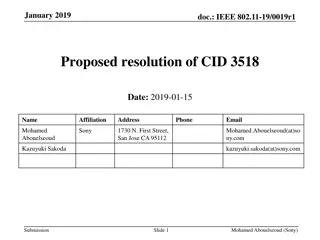Understanding Multi-Band, Multi-Channel Concept in IEEE 802.11be
Explore the advantages of Multi-Band, Multi-Channel (MBMC) operation in IEEE 802.11be, focusing on efficient spectrum use, increased data rates, and dynamic band switching. Learn about usage models and compare with single-band operations. Discover how MBMC enables concurrent operation across multiple bands for enhanced network performance.
Download Presentation

Please find below an Image/Link to download the presentation.
The content on the website is provided AS IS for your information and personal use only. It may not be sold, licensed, or shared on other websites without obtaining consent from the author. Download presentation by click this link. If you encounter any issues during the download, it is possible that the publisher has removed the file from their server.
E N D
Presentation Transcript
June 2019 doc.: IEEE 802.11-19/1231r1 Multi-Band Multi-Channel Concept in IEEE 802.11be A Simple Study Date: 2019-07-15 Name Affiliation Address Phone Email Cypress Semiconductor Corp Sai Nandagopalan snan@cypress.com Submission Slide 1 Sai (Cypress)
June 2019 Why Multi Band Multi Channel (MBMC)? doc.: IEEE 802.11-19/1231r1 New ways of operating in bands Efficient use of spectrum Leveraging underutilized spectrum Increased data rates Network load balancing Dynamic fast switching between bands/channels Submission Slide 2 Sai (Cypress)
June 2019 Usage Models from Channels Perspective doc.: IEEE 802.11-19/1231r1 The following are the usage models envisioned for MBMC operation Let us look at the typical spectrum below (just representative only) 5.0 GHz 5.0 GHz 5.0 GHz 2.4 GHz UNI1 and UNI !! Bands UNI iii and UNI !V Bands UNI V to UNI 1X Bands The BSS may be formed in any single band or can be formed with multiple band aggregation There are pros and cons of the above Submission Slide 3 Sai (Cypress)
June 2019 doc.: IEEE 802.11-19/1231r1 Single Band Operation Today s 802.11a/b/n/ac/ax operate fully in only one band There are two modes of operation today in Single Band Single band contiguous Ex: 20 MHz BSS or 40 MHz BSS or 80 MHz BSS or 160 MHz BSS Single band non-contiguous Ex: 80+80 MHz BSS 80+80 MHz BSS 20 MHz BSS 40 MHz BSS 80 MHz BSS 160 MHz BSS 2.4 GHz 5.0 GHz 5.0 GHz 5.0 GHz UNI1 and UNI !! Bands UNI iii and UNI !V Bands UNI V to UNI 1X Bands Routers are available for above devices Submission Slide 4 Sai (Cypress)
June 2019 doc.: IEEE 802.11-19/1231r1 Multi Band Operation Can form BSS across multiple bands Two ways of Operation Concurrent asynchronous Concurrent synchronous In both cases, we can have APs and non AP STAs and depending on what device is capable we can see few deployment scenarios Isn't FST already doing part of it? Is FST sufficient or not? Submission Slide 5 Sai (Cypress).,
June 2019 doc.: IEEE 802.11-19/1231r1 Concurrent Asynchronous Concurrent asynchronous devices have multiband concurrent operation Each band operates independently and simultaneously Dual band and triband concurrent routers Different non-AP STA devices can be connected to different APs in the collocated device May use BTM Request (802.11v) to transfer from one band to another band A concurrent asynchronous non AP STA may transfer one of its streams from one band to another to enhance user experience Delay, packet loss, jitter, load balancing etc FST protocol can be used 2.4 GHz BSS1 5.0 GHz BSS2 5.0 GHz BSS3 Submission Slide 6 Sai (Cypress).,
June 2019 doc.: IEEE 802.11-19/1231r1 Concurrent Synchronous 2.4 GHz Concurrent synchronous devices have multiband concurrent operation All bands and operating channels are combined to present a single BSS Can consider today s 80+80 MHz operation in one band as an example although this concept extends to multiple bands The maximum bandwidth 802.11be is touting is 320 MHz The operation of the concurrent synchronous device is similar to what we see as 160 MHz operation in a single BSS with 80+80 MHz Will have primary and secondary channels Non AP STA devices may operate on entire bands/channels as the AP to which they are associated or operate in one band/channels or partial multiple bands/channels Ex: 80 MHz STA associated with 160 MHz AP today 5 GHz UNI 1 Example of 1 BSS across multiple bands 5 GHz UNI 3 6 GHz UNI 5 Submission Slide 7 Sai (Cypress).,
June 2019 doc.: IEEE 802.11-19/1231r1 Scenario 1 AP Asynchronous concurrent and non AP STA has support for multiple band/channel but can operate on only one band/channel at any instant Ex; AP operates on 20 MHz BSS 1 in 2.4 GHz, 80 MHz BSS 2 in 5 GHz and 80 MHz BSS in 6 GHz Ex: non AP STA has support for all three bands but can operate (connect) in only one band at a time Each band has unique MAC address It is possible that the AP and/or non AP STA may decide to move all traffic or partial traffic from one band to another band to enhance user experience This can be accomplished by FST or agile multiband [1] Ex: STA based FST and Stream based FST Block ACKs are independent depending on transparent or non transparent IEEE Spec revmd 2.2 already covers it Helps QoS and load balancing and efficient in power savings from non AP STA perspective. Fast switching is also achieved Submission Slide 8 Sai (Cypress).,
June 2019 doc.: IEEE 802.11-19/1231r1 Scenario 1 Multiband architecture of revmd 2.3 section 4.6 (non transparent FST) Architecture of AP Multiband Management 802.1X 802.1X MAC SAP MAC SAP MACx MLME MLME MACy SME PLME PHYx PHYy PLME Architecture of non AP STA 802.1X General STA architecture of STA from revmd 2.3 section 4 MAC SAP MLME SME PLME Submission Slide 9 Sai (Cypress).,
June 2019 doc.: IEEE 802.11-19/1231r1 Scenario 2 AP is Asynchronous concurrent and non AP STA has support for multiple band/channel but can operate on those bands/channels independently and simultaneously at any instant Ex: non AP STA has support for 20 MHz in 2.4 GHz and 80 MHz in 5 GHz The association and authentication happens in both bands/channel simultaneously since non AP STA is capable Each band can have unique MAC addresses or same MAC address It is possible that the AP and/or non AP STA may decide to move all traffic or partial traffic from one band to another band to enhance user experience This can be accomplished by FST or agile multiband There is need for block ACK in case the communication happens on both channels simultaneously in a fashion scheduled by AP Although the author and few folks who designed FST claim that this can be achieved, the IEEE spec is not clear on this aspect wherein the same stream can be transmitted out of order in both the bands having one universal Block ACK agreement with a possible reordering mechanism In case BAs are independent in both bands, then there is a need for scheduler at upper layer on how to route traffic Helps QoS, load balancing and fast switching This will be power hungry from non AP STA perspective as it has to process all traffic in both channels simultaneously Submission Slide 10 Sai (Cypress).,
June 2019 doc.: IEEE 802.11-19/1231r1 Scenario 2 Architecture of AP/non AP STA Multiband architecture of revmd 2.3 section 4.6 (non transparent FST) Multiband Management 802.1X 802.1X MAC SAP MAC SAP MACx MLME MLME MACy SME SME PLME PHYx PHYy PLME Submission Slide 11 Sai (Cypress).,
June 2019 doc.: IEEE 802.11-19/1231r1 Scenario 3 AP is Synchronous concurrent and non AP STA has support for multiple band/channel but can operate on only one band/channel at any instant The primary channel is decided by AP Any change of the STAs traffic from one channel to another channel can be done by Agile multiband or FST AP can have one unique MAC address across bands/channels or different MAC addresses and non AP STA may have one or multiple MAC addresses New concepts for 11be There can be multiple primaries for different bands/channels Security can be done in one band for all bands The non AP STA can be parked anywhere (any channel/band) Need new rules for CCA if the STA is not parked on primary and how to asynchronously communicate from non AP STA The above two sub-bullets warrant new protocol mechanisms Helps QoS, load balancing and efficient spectrum utilization Efficient from non AP STA perspective Submission Slide 12 Sai (Cypress).,
June 2019 doc.: IEEE 802.11-19/1231r1 Scenario 3 Two possible architecture of AP Multiband architecture of revmd 2.3 section 4.6, (transparent FST) Multiband Management 802.1X MAC SAP SME SME MACx MLME MLME MACy PLME PHYx PHYy PLME Multiband architecture of revmd 2.3 section 4.6 transparent FST as implemented in open source bonding driver of linux kernel 2.0 and above) Multiband Management 802.1X MAC SAP MAC SAPx MAC SAPy SME SME MACx MLME MLME MACy PLME PHYx PHYy PLME Submission Slide 13 Sai (Cypress).,
June 2019 doc.: IEEE 802.11-19/1231r1 Scenario 4 AP is Synchronous concurrent and non AP STA has support for multiple band/channel and can operate on all bands/channels simultaneously but independently at any instant The primary channel is decided by AP Any change of the STAs traffic from one channel to another channel can be done by Agile multiband or FST AP has one unique MAC address and non AP STA may have one or multiple MAC addresses Non contiguous OFDMA can be used to communicate with the STA and allocation can happen to STA at any band New concepts There can be multiple primaries (the TGbe may decide against it) or the non AP STA may be concurrently connected to different APs The non AP STA can be parked anywhere (any channel/band) Need new rules for CCA if the STA is not parked on primary and how to asynchronously communicate from non AP STA The above two sub-bullets warrant new protocol mechanisms Helps QoS, load balancing and efficient spectrum utilization Efficient from non AP STA perspective Submission Slide 14 Sai (Cypress).,
June 2019 doc.: IEEE 802.11-19/1231r1 Scenario 5 AP is Synchronous concurrent and non AP STA has is similar to AP Although this appears new, it is new at RF layer to mixed signal layer and once it reaches PHY, it is processed as a single stream Efficient spectrum utilization, peak rate achievement and also very expensive Similar to operating STA in 160 MHz mode that is done today If the AP were to pick channels in different bands efficiently, then once can reach high spectrum utilization Power hungry from non AP STA perspectice Submission Slide 15 Sai (Cypress).,
June 2019 doc.: IEEE 802.11-19/1231r1 What is there in revmd? Revmd 2.3 says the following Architecture well defined and let us look at the architecture explanation The architecture already envisions multiband device with support for multiple bands/channels Submission Slide 16 Sai (Cypress).,
June 2019 doc.: IEEE 802.11-19/1231r1 What is there in revmd? Current draft Architecture well defined FST is approx. 9 years old Security and control can be redesigned for new scenarios for 11be Similarities with MLA (Document 823/19) No need to introduce MLO device concept as it is there in both the figures. MLO entitiy is already there (MLLE is same as in FST architecture) See next slide Submission Slide 17 Sai (Cypress).,
June 2019 Similarities between 0823/19 and Current Architecture doc.: IEEE 802.11-19/1231r1 MLO Entity already exists. If there is one MAC SAP it is transparent FST architecture BA, Security PN is maintained by multiband entity of FST This does not preclude us developing new feature with same architecture it TGbe determines that it is required MLO device is nothing but non transparent FST where multiple MAC SAPs are exposed to higher layers Additionally MLO device forces upper layers to make scheduling decisions based in link conditions DS DS MLO Device Common mgmt. signaling across MLO Entity 1 and MLO Entity 2 MAC Addr (M1) MAC Addr (M2) MAC-SAP-a MAC-SAP-b MLO Entity 2 MLO Entity 1 Common BA session, SN/PN, security Common BA session, SN/PN, security STA (MAC/PHY) x STA (MAC/PHY) y STA (MAC/PHY) z Submission Slide 18 Sai (Cypress)., WM WM WM
June 2019 doc.: IEEE 802.11-19/1231r1 What is there in revmd? Additionally, if TGbe wants to redesign FST there is a way as it does not preclude simultaneous operation (section 11) It is clear that FST can be kept alive in both bands at the same time It is also clear that the FST session is kept alive in old band even if the data moves in the new band The author does not advocate to use FST but only wants to point out that architecture exists in draft and we can create new features for multi-link by referencing to it Submission Slide 19 Sai (Cypress).,
June 2019 doc.: IEEE 802.11-19/1231r1 Practical Implementation Bonding driver exists in linux implementation since the inception of kernel 2.0 of FST in some practically available system and that will accomplish most of the scenarios outlined in MLA presentation (Figure courtesy: Carlos/Intel) control Bonding driver: is an open source driver used for bonding multiple network interfaces Allows exposing a single IP/MAC address towards network stack We use existing driver as-is to implement FST data path switching Network LIB wpa_supplicant / hostapd FST Manager User Space Data switch control NL80211 Network stack MAC80211 CFG80211 Data Bonding Driver Traffic Control (TC) FST Manager: implements data switching policy Data Data control wlan1 11ad device wlan0 11ac device Supplicant: Single instance manages both interfaces to control FST state machine Kernel https://www.kernel.org/doc/Documentation/networking/bonding.txt Submission Slide 20 Sai (Cypress).,
June 2019 doc.: IEEE 802.11-19/1231r1 Summary Multiband architecture in revmd is sufficiently general and allows scope for any new innovation to support 11be multi-link or carrier aggregation capabilities In case the group wants to use FST, then there is a need to modify the transparent FST to adapt it to the concept of (maybe having multiple MAC addresses although this concept is extended in bonding driver of linux kernel 2.0) Multiband management entity or bonding driver that is already present presents one MAC SAP to higher layers Need to clearly spell that security and other control actions in one band will automatically apply in multiple bands OCT is there in specification and may need to be simplified Additionally at higher layer, MPTCP exists and can aggregate links across technologies and is active in most of the cellular and laptop products Most smartphones manufactured after 2016 support it Based on above points, new architecture as proposed in 0823/19 needs further study if those architecture concepts are really required and wants to group to defer any strawpolls Submission Slide 21 Sai (Cypress).,
June 2019 doc.: IEEE 802.11-19/1231r1 References [1] https://www.wi-fi.org/discover-wi-fi/wi-fi-agile- multiband Submission Slide 22 Sai (Cypress).,
